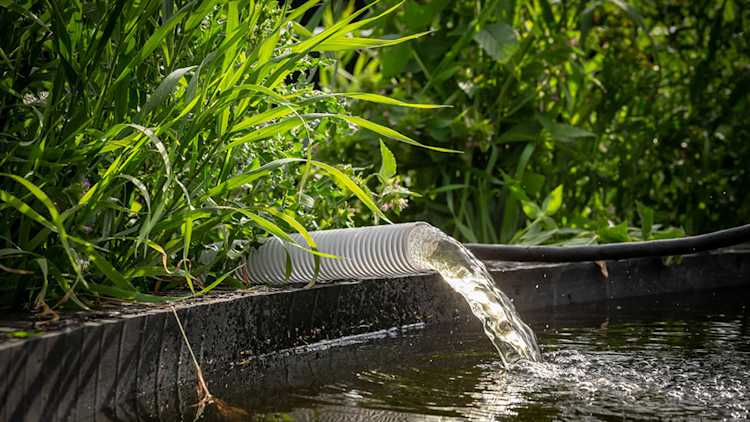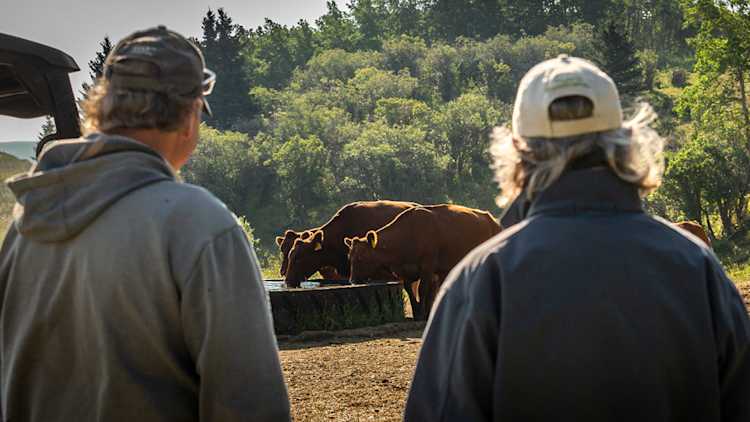Strategic alliances support a farm and ecosystem

Crystal clear water – that’s what Glen and Kelly Hall discovered years ago when they encountered the free-flowing spring at Timber Ridge, southwest of Nanton, Alberta. The couple was purchasing property in the area for themselves and for the ranch they managed. They were struck by the realization that the spring also fed their farm miles away.
“It was an ‘ah ha’ moment for us,” Kelly says. “The water at the ranch was very pure and crystal clear, yet the water we were irrigating from along the Mosquito Creek was not.”
The watershed was a unifying factor – and something the Halls immediately wanted to help protect.
“We started to understand what a gift we had because we were dealing with a wide variety of elevation, topography, climate, soil and vegetation. As both properties grew, it gave us a view of what it really meant to be a farmer and a rancher and how each property could benefit the other.”
Today, the Halls continue to seek that wide perspective on their business. With their farm in Stavely and their sprawling 1,120-acre ranch on Timber Ridge, the Halls have garnered a reputation for their unwavering dedication to sustainable farming practices, environmental stewardship and the establishment of robust community partnerships.
Fostering deep roots
With over 35 years of experience in ranch and farm management, the Halls initially served as general managers for Bar None Ranches, a once-expansive operation that encompassed 10,000 acres of cultivated land, grassland and pasture.
“We learned a lot of the hands-on, everyday work, but also moved into regenerative mode,” Kelly says. With drought being a persistent reality, regenerative agriculture became a strong part of the way they focused everything.
Prioritizing soil health and water management systems became central to their efforts. “We know that for healthy soil, we need to capture every single drop of rain and ensure that the soil is equipped for it,” Kelly says.
Keeping the watershed ecosystem healthy became paramount to their planning.
Building a community of allies
Through strategic partnerships with organizations such as Ducks Unlimited, Cows & Fish, the Foothills Forage and Grazing Association, and the Oldman Watershed Council, the Halls have demonstrated the power of community in building a resilient agricultural business.
A pivotal moment came when the opportunity arose to collaborate with the Alberta Conservation Association (ACA). As Bar None Ranches dissolved, the Halls were offered the chance to purchase some of the properties. The Halls knew the importance of the diverse grassland, mixed forest and riparian habitats – including the free-flowing spring that Kelly estimates produces “an amazing amount of water.”
The Halls worked with Sheldon Atwood, president and CEO of Western Ranchlands Corporations, to draft a unique business plan aimed at a partnership between themselves and the ACA.
This collaborative approach enables both parties to contribute their expertise and ensure the long-term sustainability of the land.
“We took the business plan to the ACA and said, ‘This is an important piece of property,’” Kelly says. The ACA recognized the value and potential of the land and committed $1 million to the project. Today, the Timber Ridge Conservation Site offers grazing opportunities, a habitat for a variety of wildlife and a steady supply of clean water.
The Halls’ partnership with the ACA extends beyond financial investment, too.
“The co-tenancy agreement speaks to the shared ownership, but we also have a management agreement that we review on an annual basis to speak about what happens on a day-to-day basis,” Kelly says. This collaborative approach enables both parties to contribute their expertise and ensure the long-term sustainability of the land.
“The ACA has done numerous studies at the ranch and now we’re teaching the next generation of stewards, of conservation folks, of biologists,” she says.
Diversifying and sticking to the plan
The Halls use a variety of management practices. “This makes the whole thing work,” Kelly says. “If we can stack enterprises on this farm, that helps us stay alive, healthy and profitable.”

They manage a calf-cow herd and operate a custom feedlot. To sustain the cattle, the couple cultivates forage while adapting to the prevailing conditions each year. Their flexibility helps protect the core of their business – the health of their land – by sticking to the principles they’ve found to be true.
“Our first principle is we never water directly from the source, not ever,” Kelly says. “Our second principle is that we always leave cover on our soil – whether it be cropland or grass or hay because the cover is like sunscreen.”
“Our third principle is high-intensity and low-frequency grazing,” she says. The practice allows the cattle to feed and the grass to grow and rest as needed.
Nurturing the future
“Our place is now a working, recreational and conservation enterprise,” Kelly says. “We want to share this place and we want this place to be a living lab for the future generations of agriculture and conservation.”
“We understand that preserving the watershed and looking after our grass also provides an opportunity for other people from society to learn, to hunt, to take pictures, to bird watch, to do whatever,” she says.
“It’s a win-win situation,” she says. Field days and visits from the community, post-secondary students and adjacent organizations offer the Halls the opportunity to help shape the future of their industry and, in turn, learn from new research, new ideas and new perspectives.
“Gathering those allies became really important in our education,” Kelly says. “We’re still not experts and there are times when we need to bring the experts to the table – whether it’s to talk to a banker or a mentor who says, ‘Don’t spend your money on sorghum-sudangrass this year, it’s too late, too dry and too hot’ – those kinds of people are critical to our operation.”
“Allies are a critical part of the growth of this farm and ranch that we want to leave to our children,” Kelly says. “We continue to build strong relationships with all those people because then our sons can just step into the roles that we have started and continue to learn with them.”
Making unique relationships work
Todd Zimmerling, the president and CEO of ACA, worked to put together the partnership between the ACA and the Halls. While he admits that the Halls are “just good people to work with,” their relationship also exemplifies key elements for successful partnerships based on shared objectives. He offers some key factors for success:
Invest in relationships
Building alliances and finding your community provides valuable support and opportunities for shared growth. “We hadn’t partnered with landowners on something like this before, but based on the relationship we built, we knew they were very committed,” Zimmerling says.
Share knowledge and learn from others
“One of the great benefits is that our staff are able to spend time talking with producers and ranchers – the people who are on the ground working with cattle on the habitat that we’re looking to conserve,” Zimmerling says. “We’ve learned a lot about how cattle ranches operate and how to have those conversations with other producers.”
Embrace new perspectives
“The relationship has allowed us to get a much better, deeper understanding of the community of landowners and producers we need to be working with – what’s important to them and what stresses they deal with,” Zimmerling says. “We now have a good sense of the real-life issues for family farms, and when we talk to a new landowner, we can ensure that we take that into account."
From an AgriSuccess article by Emily Leeson.

Renewable energy sources have become a viable alternative for many Canadian farmers. Learn how the industry is embracing solar and wind and why farmers are making the transition.
